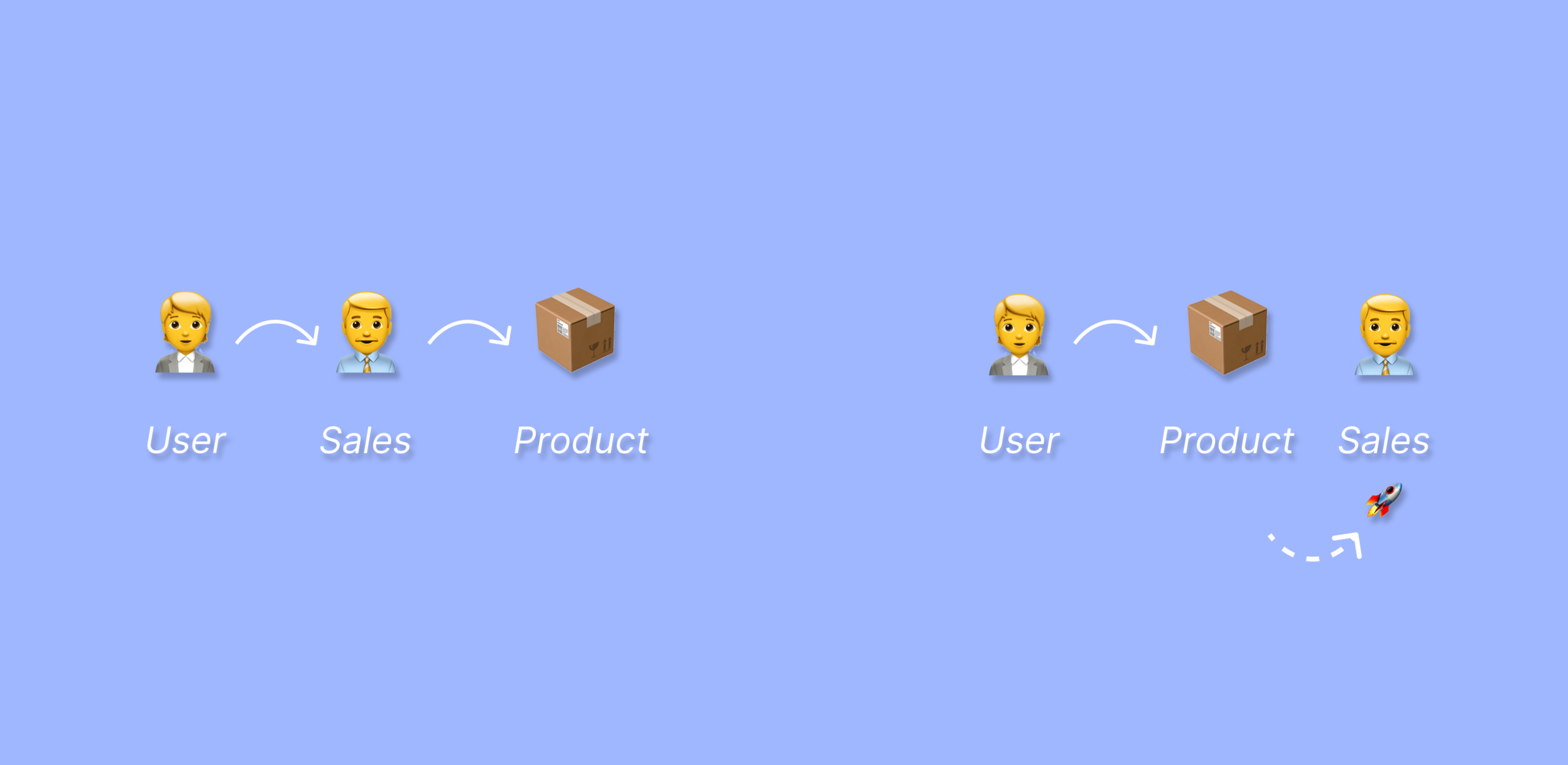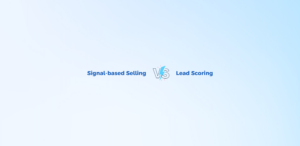What does it take to stand out in today’s crowded SaaS marketplace? A great team or awesome management? What about stellar customer service?
These are all important, but the market trends are pointing in a different direction!
Customers are demanding more than just a run-off-the-mill SaaS product experience. They are tired of sales pitches and lengthy, confusing demos. They want to try a product before they pay for it. You know, take it for a test drive!
What if your product could do the talking, convincing, and selling all on its own?
No, we are not talking about an imaginary world. Read on to discover how switching to a product-led sales strategy can help you do just that.
TL;DR
👉 This article explores the transition from traditional sales strategies to a product-led sales (PLS) approach in the SaaS industry.
👉 It highlights the weaknesses of sales-driven businesses and how adopting a PLS strategy can address them.
👉 Two success stories of leading SaaS companies, AnnounceKit and Make, that display the PLS motion’s potential.
👉 The article also outlines key steps for implementing a PLS approach and a few insider tips for managing the transition.
The Shift from Traditional Sales to Product-Led Sales Strategy

Product-led or not, the goal of every marketing and sales team is to guide users toward actions that move them closer to conversion.
This is why understanding consumer behavior and critical product activities becomes essential. Now the question is, which one of these approaches performs better?
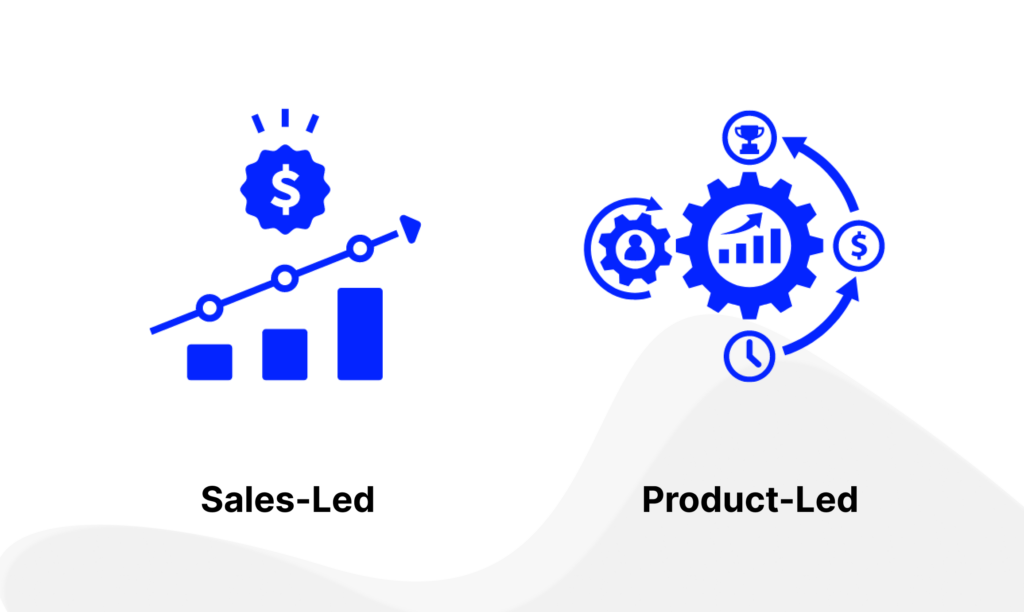
- Product-led growth strategy uses the product as a catalyst. It focuses not only on driving sales but also on fostering sustainable growth across various aspects of the business.
- Sales-led growth strategy relies entirely on the sales team, focusing on generating revenue through traditional sales activities.
The answer is a blended model that seamlessly integrates the strengths of both into a single, formidable sales strategy; the product-led sales (PLS) motion.
Shortcomings of Traditional Sales Strategies
It’s accurate to say, many businesses started with a classic sales team and succeeded too. So why has this strategy become a matter of debate?
A sales-led approach uses sales as the primary driver for growth. Its profitability depends on sales activities rather than organic growth or marketing efforts.
While it might generate revenue, it does not offer a sustainable solution. The following are some setbacks a sales-led business could face:
- Initial friction: Because it takes time to create client connections, sales-led methods may have slower growth at the outset.
- Loss of control: Relying exclusively on sales might lead to losing control over the outcome. This keeps a business struggling to chase more customers without sacrificing the product’s quality.
- Lack of scalability: The sales staff encounters multiple limitations due to poor MQL practices and disconnection between marketing and sales.
- High customer acquisition costs (CAC): Sales-driven businesses charge customers a premium price to ensure profitability. These high costs make up for the pricey acquisition system, while keeping the company vulnerable to competitors. Take a look at these statistics by FirstPageSag, for instance:
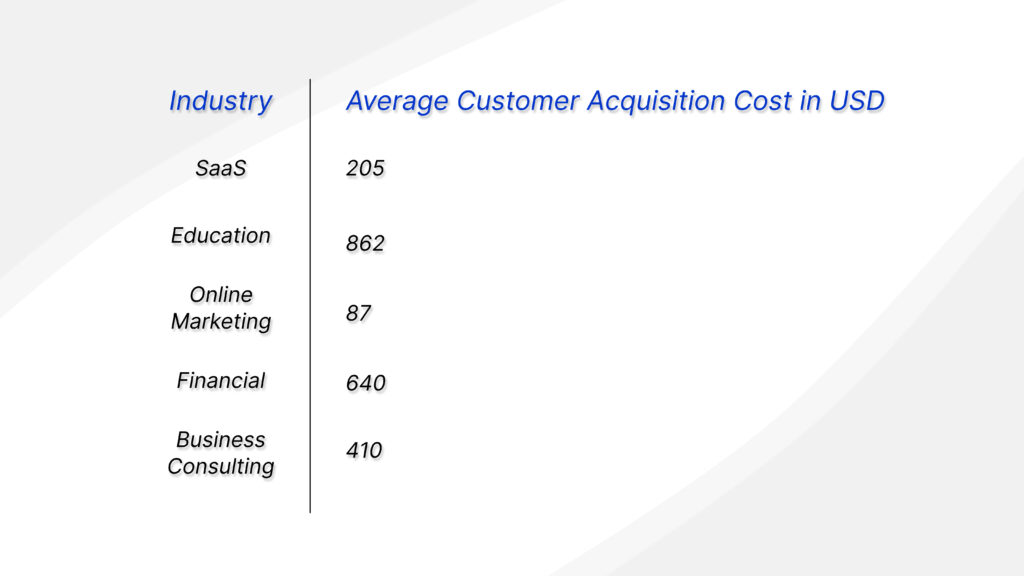
- Lengthy sales cycles: The high-touch sales models lengthen sales cycles. This can cause delays in achieving higher purchase rates, while negatively affecting revenue generation.
- Lower product quality: In sales-led organizations, sales are usually given precedence over product development. This results in skimpy quality control and a low-performing product.
These are valid and undeniable issues that most sales-led companies would acknowledge. In light of these setbacks, how does adopting a product-led sales strategy make a difference?
How Product-Led Sales Addresses These Limitations
Product-led sales is founded on a self-service system where consumers can walk themselves through their journey as buyers.
That’s why product takes the central role in delivering the experience and increasing consumer engagement.
The hands-on experience you’re offering allows your potential customers to explore and experience the product’s value. This also reduces initial friction and lowers your customer acquisition costs.
PLS motion also strikes a balance between pursuing a larger customer base and maintaining product quality.
But that’s not all! The lone ranger sales teams no longer have a place in a product-led setting. In this model, the sales, products, and marketing teams work together to reach their unified goals.
Core Advantages of Adopting a Product-Led Sales Strategy
When you imagine yourself in your buyer’s position, it becomes clear how important offering a demonstrative strategy like PLS is. However, the perks of this customer-centric approach do not end at sales.
Other advantages of adopting a PLS strategy include:
Reduced Customer Acquisition Costs
Product-led strategies lower customer acquisition costs. Developing a self-serve product not only improves the users’ experience, it also keeps them more engaged.
This also frees up more time for your sales teams to work on more important tasks, such as planning and strategies.
Cross-Team Collaboration
When the product drives the sales process, customers will have a say on what features should be added, changed, or discontinued.
That’s why improving the product is equivalent to customer experience and should move to the top of the priority list across the board. This leads to dissolving silos and achieving a functional cross-team collaboration.
User-Centric Product Improvement
Accessing a complete set of user feedback and user action data is a treasure trove for your product team’s innovation.
Users, in turn, become more engaged with the product that solves their problems and resonates with their wants and needs.
Empowering User Self-Discovery
Allowing consumers to interact with the product on their own minimizes sales cycle friction.
Moreover, it saves time for both users and the sales staff, while building customer satisfaction and loyalty.
There are many advantages to implementing a PLS approach. However, the core benefits of this strategy lie in the use of customer data for better decision-making, and increasing revenue and profit margins.
Leveraging Data for Improved Decision-Making
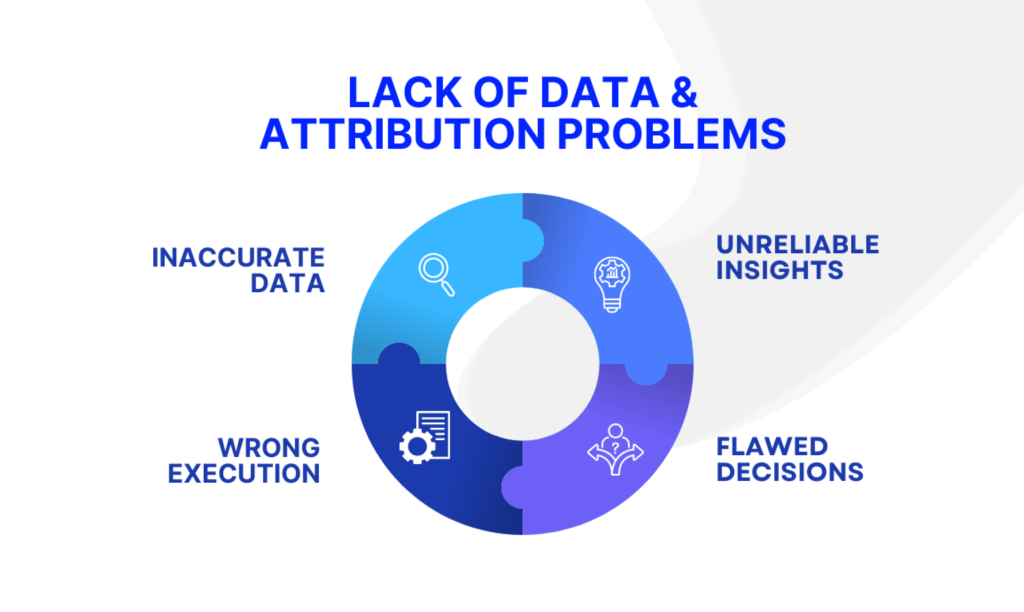
Does a data-driven business provide user-focused products?
First and foremost, a company that collects users’ data can make data-driven decisions. They can measure qualitative and quantitative user data to improve their products, and even create new features.
The better you understand your customer’s needs, the more satisfying the customer experience you can offer. Collecting and analyzing user data can help you and your team to arrive at laser-focused product decisions and respond accordingly.
Product-led businesses use these critical indicators to discover areas for development and make meaningful decisions that result in higher revenue. Consequently, they’ll position themselves for future success and build better products that fulfill consumer expectations.
Increasing Revenue and Profit Margins
Fostering higher product adoption, ongoing engagement, and opportunities to upsell or cross-sell features are some of the profit-related advantages of a PLS strategy.
But how does PLS help financial growth in technical terms?
The Head of Product at Format, a notable product-led company, used SaaS monetization approaches to boost revenue growth.
He explained three essential objectives behind his decision: boosting prices, modifying plans, and implementing clever discounts.

Companies often underestimate monetization practices, while it plays an elemental role in boosting monthly recurring revenue (MRR).
Here are some of the main aspects of boosting the bottom line using a PLS approach:
Pricing Models
Price increases should be based on the offered value, not based on the company’s costs. The right way to establish a successful payment plan is through pricing studies.
User statements about affordability, a low churn rate, and strong product stickiness (the lasting connection between the product and its users) are all indicators of underpricing.
To optimize your plans, it’s important to analyze consumer distribution and the availability of the features at various price points.
New Features and Discount Plans
Smart discount strategies can increase both conversions and revenue retention. For instance, you may offer cheap yearly plans, seasonal discounts, or free add-ons for a short period to encourage users.
Besides discounts, you can boost revenue by developing new goods or features to solve emerging problems or demands.
Constant Reiteration
Implementing pricing strategies is neither straightforward nor permanent. To understand what’s your next best course of action and keep up with the market, every business needs to constantly observe, test and reassess its monetization strategy.
Real-world Success Stories of Product-Led Sales Strategy
Looking up to the leaders in any field always helps to come up with great ideas. Here are some of the SaaS companies that adopted a PLS strategy and how they succeeded:
AnnounceKit
Founded in 2018, AnnounceKit‘s growth has been astonishing thanks to a product-led strategy.
The company created a robust product communication platform that allows businesses to successfully engage and improve their user experience.

They allow consumers to experience the benefits of their platform firsthand through free trials and freemium subscriptions.
Their focus on user-friendly interfaces, adaptable designs, and seamless integration has enabled many companies to make effective product launches and upgrades.
AnnounceKit’s user-centric strategy resulted in substantial growth, making them a trusted solution for businesses around the globe.
Their success story exemplifies the value of a product-led strategy in providing excellent user experiences while driving growth.
Make
Make, previously known as Integromat, was founded in 2012. It adopted a product-led strategy and put customer satisfaction at the forefront of its strategies.
Its user-friendly platform allows even non-tech-savvy users to simply build automated workflows.
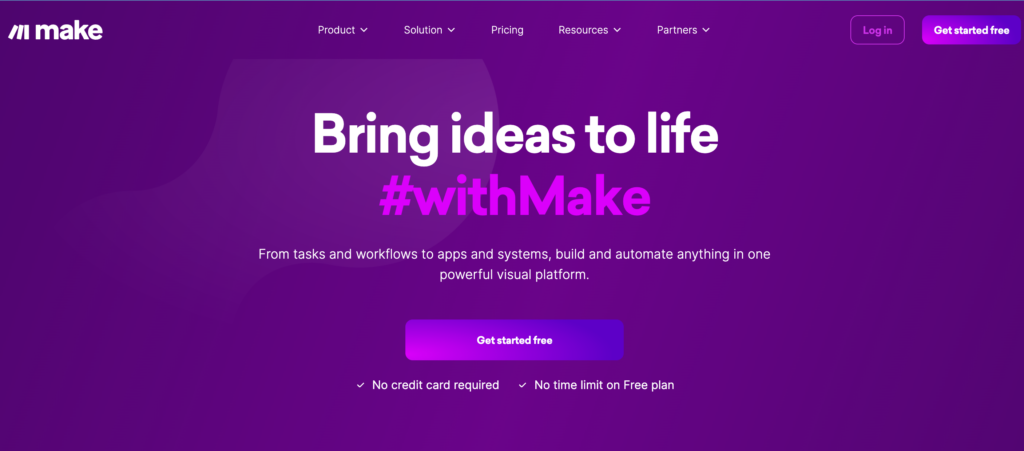
They offer free trials and a freemium model that enable customers to directly experience the platform’s benefits before upgrading to paid subscriptions.
Make’s focus on providing a smooth user experience and great customer service has paid off.
They’ve established themselves as one of the leaders in automation, generating a robust user community.
Making the Switch: Transitioning to a Product-Led Sales Strategy
Just about every company can develop a valuable product. However, a SaaS business is made of multiple compartments with competing initiatives.
The actual challenge lies in prioritizing the areas that need to become product-led. Shifting to a product-led sales strategy requires a few fundamental changes: A shift in perspective, planning, and team operations.
The best PLS practices help place an emphasis on creating a product and experience that truly resonates with your customers. This guide allows you to successfully shift from a sales-led to a product-led sales model.
This transition will pave the way for sustainable, long-term growth for your business.
Key Steps for Implementing a Product-Led Sales Approach
Let’s walk through the key steps to consider when making the switch, starting with the single, most important question:
Step 1: Is PLS for You?
The first step is to look at your existing sales strategy and see how your company can benefit from adopting a product-led approach.
Where to look? Consider factors like your target market, product maturity, customer base, and organizational readiness.
Only if you find that PLS is the right choice for your company, go ahead and implement it.
Step 2: Perspective is Everything
The next step is establishing the right mentality. You want complete alignment across teams_ sales, marketing, product, and customer success_ to support the transition.
This is about fostering a product-centric mindset within your organization. If needed, set up training sessions to promote a deeper understanding of your product’s value proposition and the goals among your employees.
Step 3: Changing Your Data Collection Behavior
The change of approach especially becomes important when it comes to data-driven decision-making.
This information should be carefully collected and used to identify areas for improvement, optimize the onboarding process, and refine your sales strategy.
Do you need to implement new tools?
It’s easy! Your systems should allow for effective tracking, measurement, and analysis of product-led sales initiatives.
Step 4: Improve Product, Ritrate, Repeat
Your team is set, and your data collection systems are in place, so what now?
Every successful product-led company improves its product’s user experience on a continuous basis. This means focusing on usability, intuitiveness, and value delivery.
A great place to look for insights is your user feedback. Using this data, iterate on product features and functionality to drive customer engagement and satisfaction.
Step 5: Setting Up New Plans
Implementing a free tier_ open trials and freemium_ together with self-service features, allow users to experience the product’s value upfront. The pricing models need to be adjusted for scalability.
Step 6: Product-Led Sales Team Enablement
Equip your sales team with the necessary training and resources so that they can sell a product-led solution.
They’ll need to perform consultative selling and communicate your product’s value proposition. The areas to work on include:
- A comprehensive product knowledge.
- Value-based selling techniques.
- Guidance on leveraging the product’s key features to address customer pain points.
Step 7: Introducing Robust Customer Success Strategies
Your goal is to help your customers achieve their desired outcomes. It could be through developing new customer onboarding programs, running proactive outreach initiatives, and designing ongoing support mechanisms.
Your PLS team can also use customer data to identify more opportunities for upselling, cross-selling, and expansion.
Step 8: Establishing an Iterative System
Transitioning to a product-led sales strategy is not a one-time event: it’s an iterative process. It’s essential to continuously gather feedback, measure outcomes, and make data-driven adjustments.
The key performance indicators (KPIs)_user adoption, conversion rates, customer retention, and revenue growth_help you understand how effective is the new strategy.
This is a rough outline of the steps for your sales to become product-led. Depending on your company and product, there might be additional steps or doing things in a different order.
Tips for Managing the Transition
We already talked about the steps and the handling of your existing leads and prospects. Here are some more pro tips if your company is in the midst of a transition to product-led sales:
- Optimizing Pricing Models: Showcase your product without relying solely on sales calls. How do you optimize in a PLS model? It may be adjusting pricing plans to accommodate freemium and discounts, offering product tours, or through pre-recorded demos.
- Unifying Data Silos: Merge data from different departments and integrate it with product data. This helps you understand the customer journey and identify product-qualified leads.
- Keeping Focus on Products: PLG requires a company-wide strategy. All teams_ marketing, customer service, and sales_ should track and contribute to product improvement. Only then can you generate high-quality leads and increase revenue.
- Lead Routing and Nurturing: Establishing an effective system for lead routing and nurturing is vital for product-led sales. Pull data from your unified Customer Data Platform (CDP) to determine which leads should enter specific nurture flows.
Why Your Business Should Consider Product-Led Sales
Before transitioning from a sales-led to a product-led approach, you’ll need to make sure a PLS model would match your company’s objectives. I’ll explain why in a moment.
Product-led motions are not something you can implement on the side. The entire organization will have to change to prioritize the product’s central role.
On the upside, these changes turn your product into a potent and sustainable growth engine. In fact, the product-led motion has become synonymous with SaaS growth and an essential business component.
More SaaS companies will embrace a product-led sales approach in the coming years. It’s just important that you know where your company stands and whether it can welcome a transition.
Frequently Asked Questions
A product-led approach helps businesses lower entry barriers and offer users free access to the product. Companies can achieve quicker and more efficient growth, resulting in a stream of engaged users who can be turned into customers.
Product-led sales simplify the user experience by allowing users to discover value before committing to payment. It also provides the flexibility for users to pay when they deem it necessary, emphasizing actual value delivered over mere advertisements.
Resources
https://tracxn.com/d/companies/announcekit/__EfId_EV8OqxFvbv9PJX5dkBledZBWGs0Tti5bQ8Ol0A

